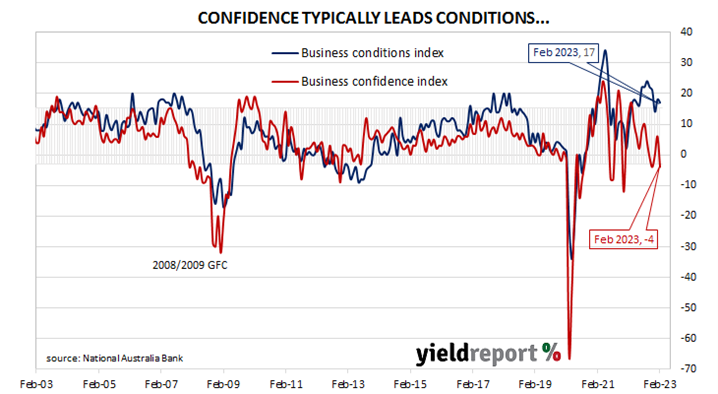Summary: Business conditions slip in February; confidence drops; confirms “ongoing resilience” of economy; consumer-facing sectors experiencing better conditions than business-facing sectors; capacity utilisation rate lower, remains elevated; Citi Australia: doubts over current market pricing of steady cash rate.
NAB’s business survey indicated Australian business conditions were robust in the first half of 2018, with a cyclical-peak reached in April of that year. Readings from NAB’s index then began to slip and forecasts of a slowdown in the domestic economy began to emerge in the first half of 2019 as the index trended lower. It hit a nadir in April 2020 as pandemic restrictions were introduced but then conditions improved markedly over the next twelve months. Subsequent readings were generally in a historically-normal range until the second half of 2022.
According to NAB’s latest monthly business survey of over 400 firms conducted in last week of February, business conditions have slipped a touch while remaining at a historically high level. NAB’s conditions index registered 17 points, down 1 point from January’s reading.
Business confidence also deteriorated but by a greater magnitude. NAB’s confidence index dropped from January’s reading of 6 points to -4 points, well below the long-term average. Typically, NAB’s confidence index leads the conditions index by one month, although some divergences have appeared from time to time.
“Overall, the survey confirms the ongoing resilience of the economy through the first months of 2023, though we continue to expect a more material slowdown in demand later in the year when the full effect of rate rises has passed through,” said NAB Chief Economist Alan Oster.
Commonwealth Government bond yields fell significantly on the day following unusually large falls of US Treasury yields overnight. By the close of business, the 3-year ACGB yield had shed 16bps to 3.05%, the 10-year yield had lost 7bps to 3.45% while the 20-year yield finished 3bps lower at 3.91%.
In the cash futures market, expectations regarding future rate rises over the next year softened considerably. At the end of the day, contracts implied the cash rate would remain essentially steady at the current rate of 3.57% to average 3.56% in April and May. August contracts implied a 3.505% average cash while November contracts implied 3.485%.
Oster noted a distinction between the economy’s various sectors. “In broad terms, consumer-facing sectors like retail and personal services are reporting conditions clustered around +20 index points, while business-facing sectors are clustered around a level of +10, which is also fairly strong.” However, he also said the drop in NAB’s confidence index “suggests the outlook remains clouded.”
NAB’s measure of national capacity utilisation remained at a historically-elevated level even as it declined from January’s revised figure of 85.8% to 85.2%. All eight sectors of the economy were reported to be operating above their respective long-run averages.
Capacity utilisation is generally accepted as an indicator of future investment expenditure and it also has a strong inverse relationship with the unemployment rate.
Citi Australia Chief Economist Josh Williamson cast doubt on current market pricing for a steady overnight cash rate in coming months. He noted “…rising labour costs, still-elevated goods prices in the business survey along with our expectation for a solid 56,000 increase in employment in February…” as counterpoints to arguments for a pause by the RBA in April.



